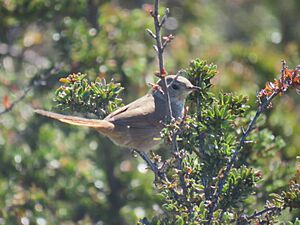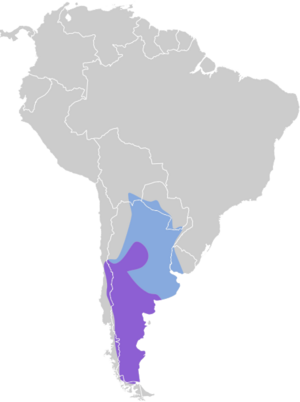Sharp-billed canastero facts for kids
Quick facts for kids Sharp-billed canastero |
|
|---|---|
 |
|
| Conservation status | |
| Scientific classification | |
| Genus: |
Asthenes
|
| Species: |
pyrrholeuca
|
| Subspecies | |
|
See text |
|
 |
|
The sharp-billed canastero or lesser canastero (Asthenes pyrrholeuca) is a type of bird that belongs to the ovenbird family called Furnariidae. You can find this bird in Argentina, Bolivia, Chile, Paraguay, and Uruguay. Sometimes, it even shows up in Brazil as a vagrant, which means it's usually not found there but visits by accident.
Contents
Bird Classification: How Scientists Group Birds
Scientists often group animals into different categories, like families and subspecies. For the sharp-billed canastero, there's a bit of a debate among experts about how many types, or subspecies, there are.
The International Ornithological Committee (IOC) and BirdLife International say there are two main subspecies:
- A. p. pyrrholeuca
- A. p. sordida
However, another group called the Clements taxonomy adds two more. These extra two are sometimes thought to be just different looks (like seasonal changes) of the first two types. For this article, we will follow the idea that there are two main subspecies.
What Does the Sharp-billed Canastero Look Like?
The sharp-billed canastero is a small bird, about 14 to 15 centimeters (5.5 to 5.9 inches) long. It weighs around 12 to 14 grams (0.42 to 0.49 ounces). It's one of the smaller canasteros and has a thin, pointed beak. Both male and female birds look the same.
Adult birds of the main subspecies have a gray-brown face with a lighter stripe above their eye. Their head is dull brown, and their back and rump are a slightly lighter brown. Their wings are mostly a dull reddish-brown. The two middle tail feathers are pointed and dark brown. The other tail feathers are mostly dull reddish with dark inner parts.
Their chin and upper throat are reddish to yellowish with dark streaks. Their lower throat and chest are pale grayish-brown. Their belly is pale buff-brown, and their sides are darker buff-brown with a reddish tint. Their eyes are brown. Their upper beak is dark gray to black, and their lower beak is gray. Their legs and feet are slate-gray. Young birds do not have the throat patch, and their chest looks mottled. The other subspecies, A. p. sordida, is very similar but has completely reddish outer tail feathers.
Where Do Sharp-billed Canasteros Live?
The main subspecies of the sharp-billed canastero breeds in central and southern Argentina. In winter, it moves north to northern Argentina and southern Paraguay and Uruguay. The A. p. sordida subspecies breeds in central and southern Chile and west-central Argentina. It winters in northern Argentina and southern Bolivia.
These birds live in many dry or semi-dry places. This includes areas with shrubs, rocky grasslands, and scrublands in both lowlands and mountains. When it's not breeding season, they can also be found in tall grass, wet areas, and the Gran Chaco scrubland. They usually live from sea level up to 2,000 meters (6,600 feet) high, but sometimes they are found as high as 3,000 meters (9,800 feet).
Sharp-billed Canastero Behavior
Movement and Migration
The sharp-billed canastero is a partial migrant. This means that some of the birds move from the southern parts of their home range to the northern parts during the southern winter.
What Do They Eat?
The sharp-billed canastero eats arthropods, which are creatures like insects and spiders. They usually look for food alone or in pairs. They pick their prey from leaves and branches, and only sometimes search on the ground.
Reproduction and Life Cycle
Sharp-billed canasteros breed during the southern spring and summer, usually from September to February. It's thought that some pairs might raise two groups of babies in one season. They are believed to stay with one partner.
They build a round nest from small twigs, about 30 centimeters (12 inches) across. The nest has an entrance on the side or near the top. Inside, they line the nest with hair, feathers, and soft plant material. They usually place their nest in the branches of a bush, up to 4 meters (13 feet) above the ground. A female bird lays two to four eggs. We don't know how long the eggs take to hatch, how long it takes for the young birds to leave the nest, or all the details about how the parents care for their babies.
How Do They Communicate?
The sharp-billed canastero's song is a two-note trill that sounds like "tsee-ee-ee-ee, tsee-ee-ee-ee." Their call to each other is a rising sound like "sweep."
Conservation Status
The IUCN (International Union for Conservation of Nature) has decided that the sharp-billed canastero is a species of "Least Concern." This means they are not currently in danger of disappearing. They live in a very large area, and while their exact population size isn't known, it's thought to be decreasing. However, no immediate threats have been found. These birds are considered quite common in most places where they live. Their habitat is affected by grazing, but not severely.
Images for kids



